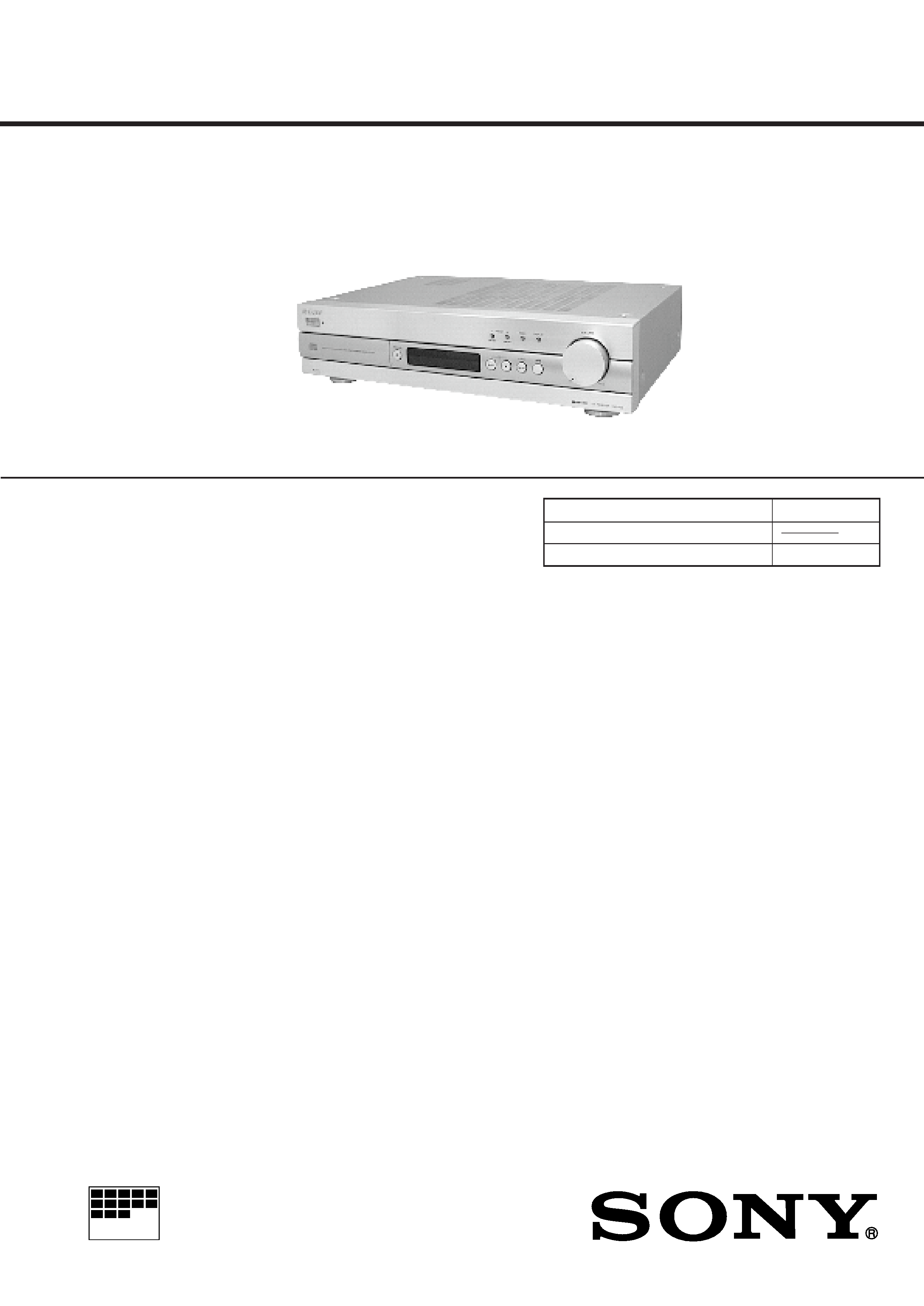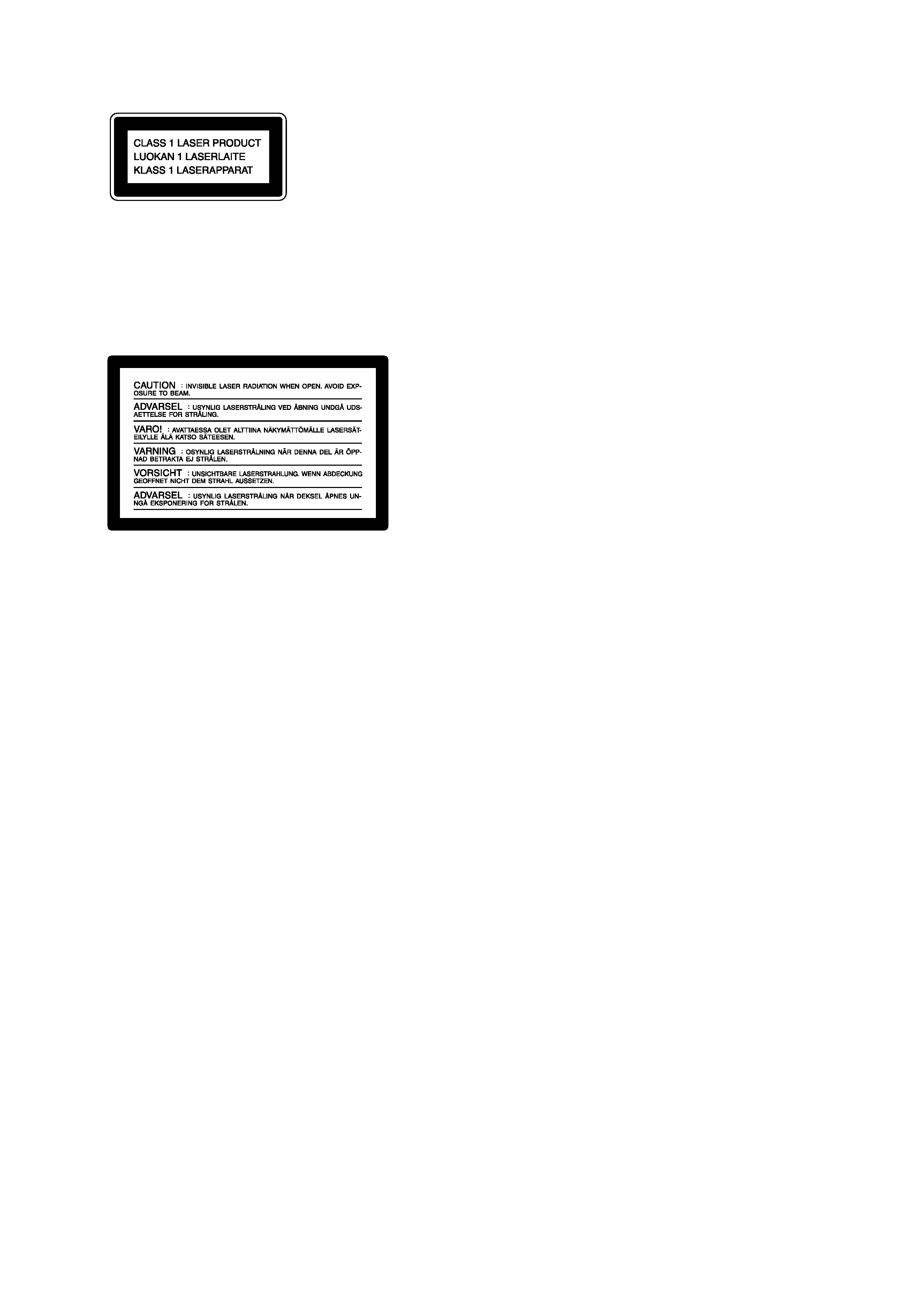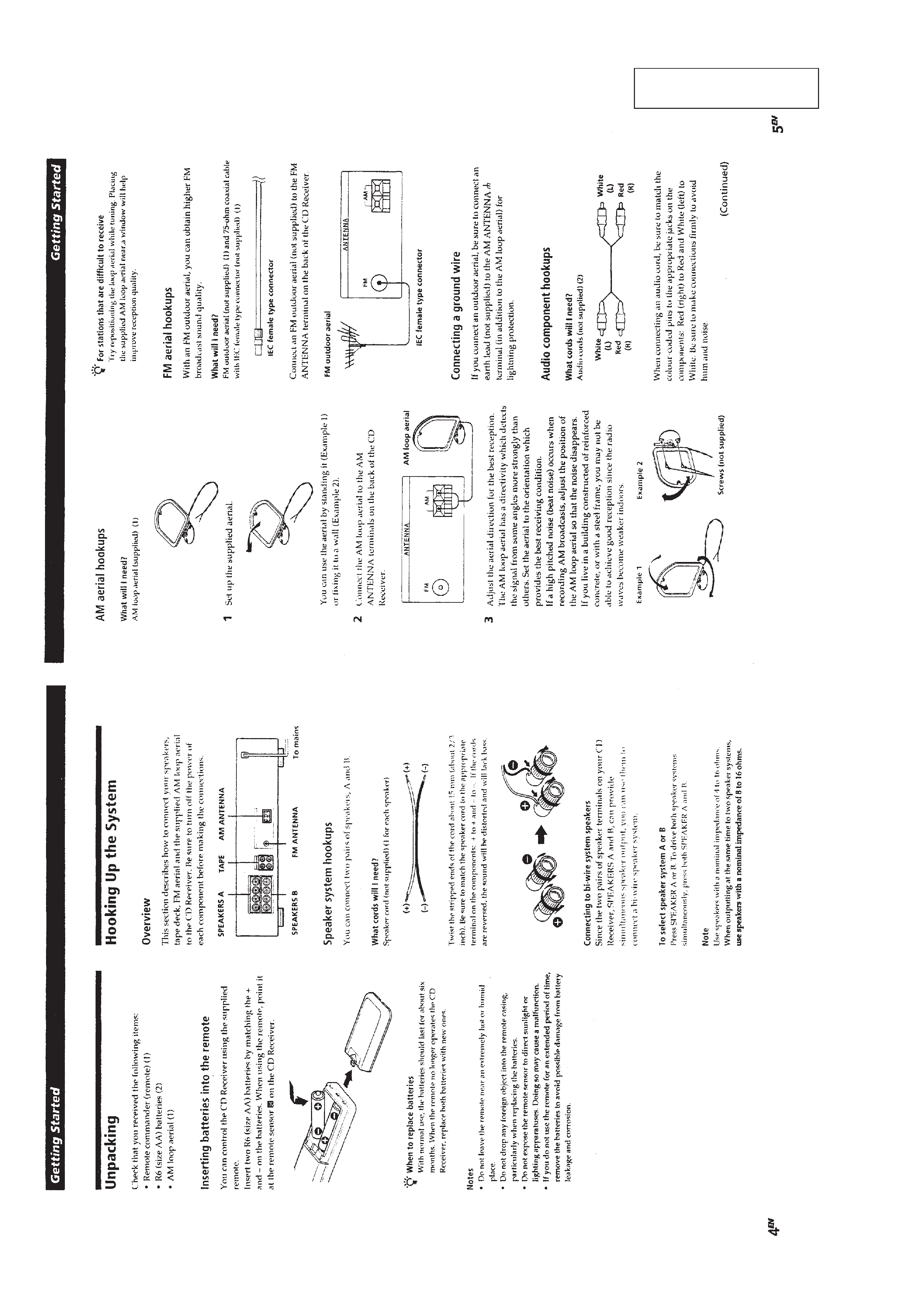
1
Model Name Using Similar Mechanism
NEW
CD Drive Mechanism Type
Optical Pick-up Name
KSS-213C/Q-RP
SERVICE MANUAL
AEP Model
UK Model
RXD-700
CD RECEIVER
Amplifier section
Continuous RMS power output
55 + 55 watts
(4 ohms at 1 kHz, 0.7% THD)
Inputs
TAPE LINE IN (phono jacks):
sensitivity 150 mV, impedance 50
kilohms
Outputs
TAPE REC OUT (phono jacks):
150 mV, 4.7 kilohms
SPEAKER:
accepts impedance of 4 to 16 ohms,
8 to 16 ohms (SPEAKER A + B).
CD player section
System
Compact disc and digital audio system
Laser
Semiconductor laser
(
= 780 nm)
Emission duration: continuous
Laser output
Max. 44.6
µW*
* This output is the value measured at
a distance of 200 mm from the
objective lens surface on the Optical
Pick-up Block with 7 mm aperture.
Wavelength
780 - 790 nm
Frequency response
20 Hz - 20 kHz (
± 0.5 dB)
Signal-to-noise ratio
More than 114 dB
Dynamic range
More than 100 dB
Harmonic distortion
Less than 0.003 %
Channel separation
More than 108 dB (1 kHz, 20 kHz LPF)
SPECIFICATIONS
Tuner section
FM stereo, FM/AM superheterodyne tuner
FM tuner section
Tuning range
87.5 - 108.0 MHz
(50 kHz step)
Aerial
FM wire aerial
Aerial terminals
75 ohm unbalanced
Intermediate frequency 10.7 MHz
Sensitivity
at 26 dB quieting
(mono) 10.3 dBf, 0.9
µV/ 75 ohms
at 46 dB quieting
(stereo) 38.5 dBf, 23
µV/ 75 ohms
Usable sensitivity (IHF) 10.3 dBf, 0.9
µV/ 75 ohms
S/N
at 40 kHz deviation
Mono: 75 dB
Stereo: 70 dB
Harmonic distortion
at 1 kHz
Mono: 0.04%
Stereo: 0.07%
Separation
45 dB at 1 kHz
Frequency response
30 Hz - 15 kHz (+0.3/-0.7)
Continued on next page
MICROFILM

2
AM tuner section
Tuning range
531 - 1,602 kHz
(9 kHz step)
Aerial
AM loop aerial, External aerial
terminals
Intermediate frequency 450 kHz
Usable sensitivity
300
µV/m
S/N
50 dB (50 mV/m, 999 kHz)
Harmonic distortion
0.3 % (50 mV/m, 400 Hz)
General
Power requirements
230 V AC, 50/60 Hz
Power consumption
150 watts
Dimensions (w/h/d)
Approx. 440
× 110 × 340 mm (17 3/8 ×
4 3/8
× 13 1/2 in) incl. projecting parts
and controls
Mass
Approx. 7.4 kg (16 lb. 5 oz.)
Supplied accessories
Remote commander (remote) RM-U301 (1)
R6 (size AA) batteries (2)
AM loop aerial (1)
Design and specifications are subject to change without notice.
SERVICE NOTE
CAUTION
Use of controls or adjustments or performance of
procedures other than those specified herein may result in
hazardous radiation exposure.
Notes on Chip Component Replacement
· Never reuse a disconnected chip component.
· Notice that the minus side of a tantalum capacitor may be
damaged by heat.
NOTES ON HANDLING THE OPTICAL PICK-UP BLOCK
OR BASE UNIT
The laser diode in the optical pick-up block may suffer electrostatic
breakdown because of the potential difference generated by the
charged electrostatic load, etc. on clothing and the human body.
During repair, pay attention to electrostatic breakdown and also use
the procedure in the printed matter which is included in the repair
parts.
The flexible board is easily damaged and should be handled with
care.
NOTES ON LASER DIODE EMISSION CHECK
The laser beam on this model is concentrated so as to be focused on
the disc reflective surface by the objective lens in the optical pick-
up block. Therefore, when checking the laser diode emission, ob-
serve from more than 30 cm away from the objective lens.
NOTES ON PICK-UP FLEXIBLE BOARD
The pick-up flexible board in this set is secured to the optical pick-
up with an adhesive tape. Once the tape is removed, an adhering
force becomes weak, and it cannot be reused.
Therefore, if the optical pick-up is replaced, replace also the pick-
up flexible board with a new one.
SAFETY-RELATED COMPONENT WARNING!!
COMPONENTS IDENTIFIED BY MARK
! OR DOTTED LINE
WITH MARK
! ON THE SCHEMATIC DIAGRAMS AND IN
THE PARTS LIST ARE CRITICAL TO SAFE OPERATION.
REPLACE THESE COMPONENTS WITH SONY PARTS WHOSE
PART NUMBERS APPEAR AS SHOWN IN THIS MANUAL OR
IN SUPPLEMENTS PUBLISHED BY SONY.
NOTES ON CLEANING THE OBJECTIVE LENS
Apply CD lens cleaner B-4 (Part No.:J-2501-000-A) to cotton swabs
(narrow type) (Part No.:J-2501-023-A) to be lightly wet. Use a force
(about 5 g (0.18 oz)) to make the objective lens in contact with the
bottom lightly, and clean the lens by spirals as following below.
Replace the cotton swab and repeat this cleaning two or three times.
Notes:
Do not force to push the objective lens. Otherwise, the plate spring
supporting the objective lens will be bent, causing a deteriorated
RF waveform.
Never touch anything other than the objective lens. Otherwise, a
significant deterioration occurs in the RF waveform.
cotton swabs
objective lens
2-axis actuator
2-axis cover
slide base
surface of objective lens

3
TABLE OF CONTENTS
1. GENERAL
Getting Started
Unpacking ........................................................................... 4
Hooking Up the System ...................................................... 4
Setting the Clock ................................................................ 5
Presetting Radio Stations .................................................... 5
Basic Operations
Selecting a Source .............................................................. 6
Playing a CD ....................................................................... 6
Receiving Preset Stations ................................................... 7
2. DISASSEMBLY
2-1. Cabinet (Top) ..................................................................... 8
2-2. Front Panel (1) ................................................................... 8
2-3. Front Panel (2) ................................................................... 9
2-4. Front Board ........................................................................ 9
2-5. Mechanism Block ............................................................ 10
2-6. Chassis (Back) .................................................................. 10
2-7. Power Transformer ........................................................... 11
2-8. Main Board ...................................................................... 11
3. ELECTRICAL ADJUSTMENTS
FM Section ........................................................................... 12
AM Section ........................................................................... 13
Audio Section ....................................................................... 13
Front Section ........................................................................ 13
CD Section ........................................................................... 13
4. DIAGRAMS
4-1. Block Diagram CD Section .......................................... 15
4-2. Block Diagram Tuner Section ...................................... 17
4-3. Circuit Boards Location ................................................... 19
4-4. Printed Wiring Boards CD Section .............................. 21
4-5. Schematic Diagram CD Section ................................... 23
4-6. Printed Wiring Board Front Section ............................. 27
4-7. Schematic Diagram Front Section ............................... 31
4-8. Printed Wiring Boards Main Section ........................... 36
4-9. Schematic Diagram Main Section (1/2) ....................... 39
4-10. Schematic Diagram Main Section (2/2) ....................... 43
5. EXPLODED VIEWS
5-1. Case Section ..................................................................... 51
5-2. Front Panel Section .......................................................... 52
5-3. Chassis Section ................................................................ 53
5-4. CD Mechanism Section ................................................... 54
5-5. Optical Pick-up Section ................................................... 55
6. ELECTRICAL PARTS LIST ................................... 56
This appliance is classified as a CLASS 1
LASER product.
The CLASS 1 LASER PRODUCT
MARKING is located on the rear exterior.
The following caution label is located
inside the unit.

4
SECTION 1
GENERAL
This section extracted from
instruction manual.

5
